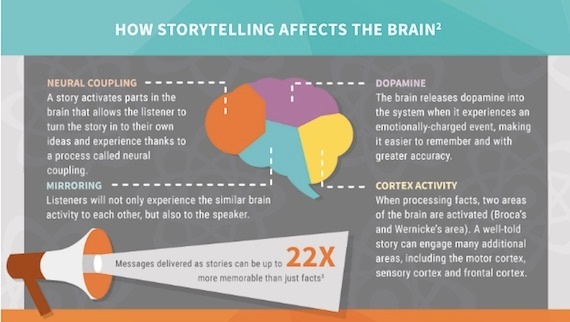Storytelling helps you to present your product or service in an exciting way and present it more successfully to your target market. In our XXL Storytelling Guide, you will learn how to make the most of storytelling in your company.
No desire to read? Listen to the blogcast here:In this article, you will learn:
- What "storytelling" means and its various forms.
- In which areas storytelling is particularly effective.
- Proven tips and tricks on how to tell your story effectively.
Jump to the appropriate section:
#1 What is storytelling?
#2 What does storytelling do?
#3 Why should companies tell stories?
#4 The Art of Storytelling: Where Stories Hide
#5 In which areas can storytelling be used?
#6 What forms of storytelling are there?
#7 Storytelling checklist: What you should watch out for
#8 Storytelling: Tips & Tricks for successful implementation
Can I have your attention for a moment, please?
Thank you very much – now, the storytelling begins.
Humans love good stories. We spend a significant portion of our free time reading books and watching movies.
However, consumers are flooded daily with meaningless advertising and cheap slogans. And there’s another problem: our attention span has dropped drastically in recent years, making it even more difficult to reach desired target groups. Companies need to find a new way to effectively reach potential customers. As a result, “storytelling” has become an effective marketing tool.
For many companies, however, telling engaging stories poses a challenge.
Because many products seem too dry, monotonous, or serious at first glance, it might seem difficult to tell a story about them. Fortunately, this is usually a misconception.
With the necessary tools, any company can tell exciting stories. We will provide you with this tool. All you have to do to become a successful "storyteller" for your company is to read this article carefully.
Admittedly, it is a long article. But it's the only one you need to read to master the art of storytelling.
So, sit back and enjoy our XXL Storytelling Guide.
What exactly is storytelling?
At this point, let's first clarify what storytelling actually means. I am sure you’re familiar with the term itself. However, storytelling is not just about telling stories. That would be far too easy.
Storytelling is "advertising through narrated stories.” The company itself steps into the background, while an emotionally appealing story comes takes the spotlight.
Storytelling is one of the most powerful ways to breathe life into your brand and is often described as one of the main components of the content-marketing approach. By giving your products and services an identity and creating stories that are authentic, you inspire your customers and attract attention.
Skillful storytelling makes difficult topics interesting (video produced by Mynd).
Storytelling is less about making up a story than about why your business exists, why you are passionate about bringing your products and services to market, and why you go to work every day with enthusiasm – it’s stories people want to hear.
But for consumers to build a personal connection to your brand, corporate stories need to be honest, creative, and inspirational at the same time.
What does storytelling do?
A good story activates parts in our brain that make us reflect on our own ideas and experiences based on that story ("neural coupling"). When experiencing emotions, our brain releases dopamine, which helps us to remember the triggering moment better.
Through neuronal coupling, this happens not only with situations we have experienced ourselves, but also when we "consume" a good story: our brain perceives the story as if it had actually been experienced. This is why we remember something 22 times as often when it was part of a story.

How Storytelling Influences the Brain (Infographics by Onespot).
These scientific findings make it clear that your business can find similar success through the utilization of storytelling in marketing.
Why your company should utilize storytelling.
Based on what you’ve read so far, it should already seem sensible to integrate storytelling into corporate communication.
Stories touch your customers emotionally and make them remember your product or service better.
In addition, they breathe life into every situation, no matter how dry it may seem.
In a world with endless information, it’s essential to stand out. There’s nothing more valuable than a prospective client’s attention. With competitive and striking advertising slogans, it’s difficult to win the competition for attention.
In order to captivate the masses, you must become a good storyteller.
Another important point: stories have a wider spread. This is where word of mouth and social sharing come into play. If you strike a particular nerve with your story, there’s even a chance of it going viral.
This works even better with videos.
One Dollar Shave Club: Spread through all social media.
Ultimately, all this is reflected in your return on investment. For example, a study found that the value of certain products was considered higher when a story was told around them.

The infographics illustrate how storytelling increases perceived values (source: Adweek).
The art of storytelling: Where stories hide.
Many marketing managers believe that their product or service is too boring to be part of an interesting story. But the exciting stories usually sleep directly beneath the surface and only require exploration.
Good stories usually derive from daily life. Often they are presented by the customers themselves, and as a company, you only have to listen closely enough to discover them.
Here are some tips on how you can tell exciting and thrilling stories about your company:
- Good content is personal. The goal of a good story is to establish a connection to your customer. You can't do this with generic statements that could have been made by any other company. Create a close relationship and identification to your customers through personality. Open yourself to your customer. Explain to him or her why your product is so important, why you have decided to bring it to the market, and how you want to help people with it. Talk about feelings.
- Be open with your mistakes. Mistakes that are communicated transparently make you relatable. Yes, really, because you prove that you are only human. That is enormously important, because customers want to be able to recognize the people behind a company. Through this form of storytelling, your brand is humanized and your customer can identify with it even better.
- Use examples from real life. Nothing convinces potential customers more than success stories from other customers. So tell these stories. Highlight the experiences of your customers, and let them tell you how your product helped them.
- Use examples from media. Are there any industry developments in the news that could have an impact on your audience? If so, write about it. This is how you create a link between an abstract event in the media and your product. The story becomes relevant for your customer and he or she establishes a connection between an event and your company.
- Be human. When you talk about your product or service, it's not about having "good business talk.” Your customers want to understand what you're talking about. Nothing is more counterproductive to a story than too much business technical blah-blah. Stay human, and show your audience that you speak the same language.
"Start with Why": Companies must place personal reasons for their actions in the foreground.
In which areas can storytelling be used?
The most important mission of any company is to make a profit and sell more (something that can be accomplished with the aid of video).
Ideally, however, storytelling will not only become part of sales and marketing, but of your overall communications strategy.
We would like to briefly address three of the most important areas:
#1 Social Media.
Think about your own behavior and that of your friends on social networks. Which messages and videos are most often shared? Surely you won't be the first to think of product information. No, it's content that makes us feel strong emotions. Here are a few examples:
- Cat videos make us laugh.
- Amazing facts surprise us.
- The fate of people makes us sad or gives us hope.
- Social injustice makes us angry.
Video with humor: Cat videos often go viral.
This is the reason why so many companies fail with their social media efforts. They don't provoke emotions. They don't tell stories.
#2 Recruiting.
The time and cost of the recruiting process is constantly increasing. And even if there are enough applicants, only a few really fit your company.
Searching for the right applicant: Zendesk presents itself in its own recruiting video
Tell applicants an exciting story consisting of the details of the job, or document the incredible team spirit during the last company outing. Become creative. Create a desire in the applicant to become part of these experiences, these stories. This will automatically expose those who do not fit your corporate culture.
#3 Internal communication.
How many employees can't wait to read the monthly company newsletter? Usually not many. Such memos are read, at best, in order not to miss any tasks or deadlines. But they don't leave a positive impression.
In addition, only a few employees actually identify with their employer or feel that they are an important part of the company. The result: employee fluctuation increases and motivation and productivity decrease.
By utilizing storytelling, you have the opportunity to build up appealing corporate culture relatively easily. Use humor, for example, to create trust and relatability. You will see what a difference it makes in work performance when employees are emotionally involved, part of a story, and experience everyday work with a sense of positivity.
The following infographics provide an overview of the most important areas in which storytelling changes the inner workings of a company:

Storytelling vs. Corporate Speak: Infographic by Ishmael's Corner.
The big advantage here is that you don't have to finance a costly company vacations or off time. Integrating storytelling intodaily communication can have a much greater impact and is far less costly and time-consuming.
Storytelling in marketing: What forms & media are there?
Almost every medium is suitable for telling stories, including blogs, videos, pictures, or social media channels. Each location triggers a different reaction and emotion in the viewer, so the stories have to be adapted to the respective medium. The key to success is knowing which story is best for which medium. Let's take a closer look at the individual channels.
#1 Storytelling in a blog.
Many people associate a good story with books—the written word. In our modern digital age, a blog can be used to tell stories.

Stories that reach the audience (Infographic from Onespot).
The challenge of blogging is to put emotions into words in a skillful way and to engage the readers. The right length must be identified, in which the message is conveyed without compromising the reader's attention.
Here are three tips to make your blog articles interesting for readers:
- Entice the reader by addressing a familiar situation. Story elements such as "You know that, too..." create a familiarity and closeness between the reader and the content.
- Focus on a protagonist rather than a process, product, or service itself. Describe the experiences and interactions of this protagonist (for example, a testimonial customer) with your actual topic.
- Structure your blog post according to a classic story structure: introduction-conflict-happy ending. In the marketing context, this could be the problem ("pain point") for readers and the appropriate solution (your product).
#2 Storytelling with pictures.
The human brain can process visual information much faster than written text. By using images, you can visually divide text, making it clearer and more readable.

Which emotions does this image trigger?
A picture provides an opportunity to elicit more emotions. So, place expressive pictures in blog posts, social media posts, mailings, and presentations.
#3 Storytelling with videos.
Increasing numbers of people prefer video to text. In fact, by 2019, videos are expected to account for as much as 80% of Internet traffic. That's good news for you, because video is incredibly well-suited to convey emotions visually and acoustically at the same time. After all, storytelling is about emotions.
Another plus: Social videos generate 1200% more shares than text and images combined. The probability that one of your stories will be viral is much higher than with plain text. Brands like the airline WestJet have been able to achieve over 40 million clicks on YouTube alone with their ingenious storytelling.
Checklist Storytelling: What you should watch out for.
#1 Identify the target audience of your story.
One of the cornerstones of successful communication is knowing your target audience. This is not only true when selling a product or service, but also when telling a good story. It is impossible to engage all people with one story. You have to define your target specifically in order to cater your story to them.
Nivea's touching video below perfectly addresses the emotions of young mothers:
Nivea demonstrates successful storytelling.
Tip:
If you don't know exactly who you want to address, you won’t know what to say or where to say it. Define your target group and your buyer personas!
#2 What goals do you want to achieve?
Even if you tell the best and most touching story in the world, your goals must always be the focus of your communication. Ask yourself: What exactly do you want to achieve with storytelling, or what action should your story prompt in the viewer?
The US American insurance company, Farmers, tells the story of a veteran who selflessly saved victims during a hurricane in Texas.

An example of successful storytelling from Farmers.
This heroic story is both touching and indirectly conveys the need for better insurance—ideally with Farmers, of course.
Tip:
Define the objective and message of your storytelling action in order to align content with the desired emotional response.
#3 Which emotions should your story elicit?
According to Dr. Robert Pluchik, psychologist and professor at Albert Einstein College of Medicine, there are eight main emotions:
- Anticipation
- Faith
- Surprise
- Dislike
- Joy
- Sorrow
- Rage
- Anxiety
Besides these, we feel a huge range of other feelings, but for your storytelling brainstorming, this list offers a good start.
Tip:
Make it clear which feelings you want to address, and then create a story that evokes those feelings.
Mercedes Benz, for example, evokes a protective instinct with this successful video, leaving us with a happy smile at the end:
Video by Mercedes Benz: evokes strong emotions.
#4 Your target group must be able to identify with the story.
People are more likely to be touched by stories with which they can identify. If you know your target group, you can empathize with them.
The Nivea story mentioned earlier is a perfect example. All mothers can put themselves in the chosen situation because they experience it every day.
What can your target group identify with? Does she have financial worries? Has she had to overcome difficult twists of fate? Maybe she is in love? Or in search of freedom and independence?
Tip:
Get to know your target group, and identify approaches for your story.
Storytelling for companies: Four concluding tips for successful implementation.
- Keep it short. The attention span of people is steadily decreasing, and there is an infinite mass of information to consume. If you can't get to the point quickly and captivate your target group, they will simply continue to scroll. In fact, 20% of desktop and 34% of mobile users have an attention span of less than 30 seconds. These statistics make it clear why you should tell a compelling story right from the start.
- Set visual stimuli. Our brain processes visual information 60,000 times faster than literal information. Use videos as storytelling tools to reach your target audience in the best possible way.
- Let your audience have their say. Give room for comments and don't forget to react to them. This turns your story (instead of a one-sided monologue) into a profitable dialogue for both sides.
- Only provide relevant information. Check whether the information you provide is really relevant and suitable for your individual target group. Less is more in most cases!
We wish you every success with your story telling project.

